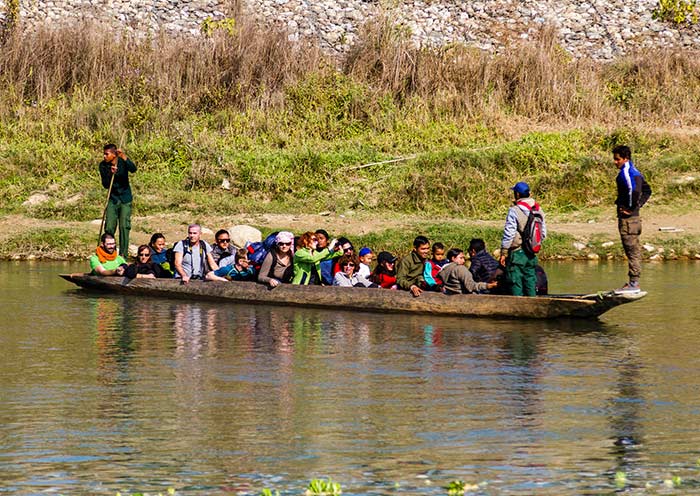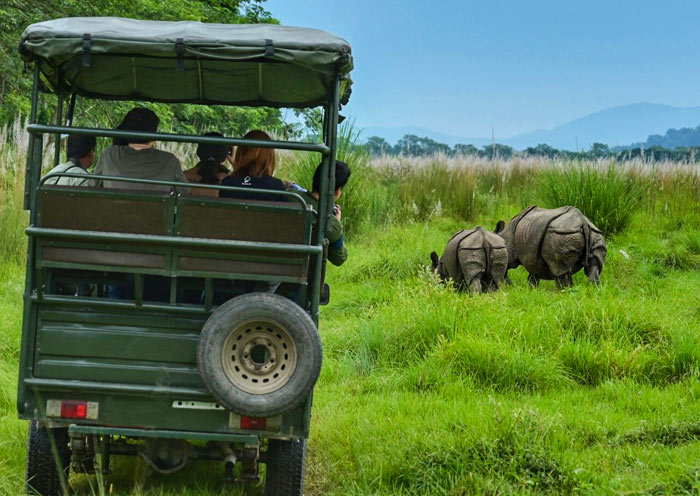We really enjoyed our 19 day tour of Bhutan, Nepal and Tibet tour arranged by Asian Odyessey. Alina helped customize our itinerary, mostly adding a few free rest days, and was very helpful in communication throughout. The tour guides, hotels and transportation were all excellent. I am happy to recommend them and indeed am looking at another tour.
- Highlights
- Itinerary
- Price
- Trip Notes
- Accommodation
- Photos
- Reviews
Looking for the most CLASSIC itinerary in Nepal? Want to make full use of your time in this amazing travel destination in Asia? Look no further. Our 8-day Classic Nepal Golden Triangle Tour is the best choice. With just over a week to spare, this itinerary is designed to make the most of your time in Nepal, ensuring a DIVERSE EXPERIENCE in three locations.
The Golden Triangle in Nepal (Kathmandu - Pokhara - Chitwan):
The journey begins in Kathmandu, the vibrant capital city. Spend four days exploring its ancient temples, royal palaces, rich cultural heritage, and bustling markets. Immerse yourself in the captivating history and spirituality that permeate the city's streets.
Next, venture to Pokhara, a serene lakeside town nestled amidst the stunning Himalayan peaks. Marvel at the breathtaking views of the Annapurna range and indulge in adventurous activities like paragliding or boating on Phewa Lake. Two days here will leave you refreshed and rejuvenated.
The final stop is Chitwan, renowned for its lush national park and abundant wildlife. embark on thrilling jungle safaris, where you can spot majestic rhinos, elusive tigers, and a myriad of bird species. Immerse yourself in the natural beauty and tranquility of this UNESCO World Heritage Site.
Go with Asia Odyssey Travel, with abundant local resources and a team providing you with the best price and expert guidance, ensuring a stress-free and memorable journey through the golden triangle of Kathmandu, Pokhara, and Chitwan.


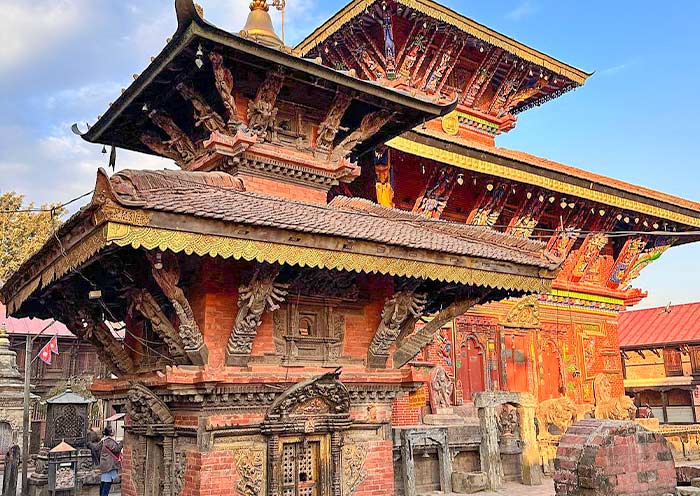




Itinerary at a Glance
Kathmandu (3 Days)
Kathmandu Durbar Square (World Heritage), Swayambhunath Stupa (World Heritage), Pashupatinath Temple (World Heritage), Boudhanath Stupa (World Heritage)
Pokhara (2 Days)
Phewa Lake, Old Pokhara, Sarangkot Sunrise, Devi's Fall, White Peace Pagoda, Gupteshwor Mahadev Cave, International Mountain Museum
Chitwan (2.5 Days)
Chitwan National Park
Patan/Lalitpur (0.5 Day)
Patan Durbar Square (World Heritage)
Itinerary Day by Day
Namaste! Welcome to Kathmandu, the capital of Nepal! Upon your arrival at the airport in Nepal, the tour guide and driver will meet you at the exit and then escort you to the hotel in downtown Kathmandu. You can have a good rest in your hotel and get ready to explore Kathmandu Valley with your guide the next day.
Kathmandu is the largest city in Nepal, located in the Kathmandu Valley, which is surrounded by the majestic Himalayan mountain range. The city boasts a rich cultural and historical heritage, with numerous ancient temples, palaces, and monuments. Its architecture beautifully blends traditional Newari style with modern designs. Kathmandu is renowned for its vibrant street life and bustling markets, such as the Asan Bazaar and the Thamel district (street), offering a wide range of goods and services. The city's rich festival culture, stunning architecture, and friendly people make it a popular destination for travelers from around the world.
Arrival Ideas: Kathmandu's Tribhuvan International Airport (KTM) serves as the main gateway to the city, accommodating both domestic and international flights. You can fly directly to Kathmandu from major cities such as Hong Kong (5.5 hours), Chengdu (2.5 to 3.5 hours), Beijing (3.5 to 4.5 hours), Shanghai (4 to 5 hours), Lhasa (1.5-2 hours), and Guangzhou (5 hours 15 minutes) in China. Other cities such as Delhi, Mumbai, Kolkata, and Bangalore in India, as well as Bangkok (Thailand), Singapore, Kuala Lumpur (Malaysia), Dubai (United Arab Emirates), Tokyo (Japan), Seoul (South Korea), London (UK), Paris (France), Frankfurt (Germany), Istanbul, New York, Los Angeles, and Toronto also offer flights to Kathmandu. The availability of direct flights to Kathmandu can also vary depending on the season and airline. So, checking with flight booking websites or our travel consultants for the latest information and options is always a good idea.


Today, you will explore 4 World Heritage Sites in the Kathmandu Valley. Begin by visiting Kathmandu Durbar Square (World Heritage), one of three royal palace squares in the Kathmandu Valley. You won't miss the Hanuman Dhoka, an iconic red palace adorned with intricate wooden carvings, which served as the residence of Malla Kings for centuries. Most of our guests arm to visit Kumari Ghar (House of the Living Goddess) and Taleju Temple (closely linked to the tradition of the Kumari). Through the Kumari Chowk, you may have the opportunity to catch a glimpse of the Kumari (a young girl worshiped as the living goddess Durga), who is revered by both Hindus and Buddhists in Nepal. The Kumari is selected from a Buddhist family through traditional tests and is believed to be the incarnation of the Goddess Taleju (Durga) until she reaches menstruation age. Dashain Festival (October; a 15-day festival) and Tihar Festival (November; Festival of Lights) offer the best chances of seeing the Kumari in public processions. The Bhairav Statue is also one of the best spots to experience Hindu culture, where you can witness local people worshipping the fearsome god Bhairav, the protector of the city.
Then, you will visit the Pashupatinath Temple (World Heritage) - a stunning pagoda-style Hindu temple dedicated to Lord Shiva. As the oldest Hindu temple in Nepal, dating back to around 400 B.C., the main temple complex located at the Bagmati River is only open to Hindus. However, non-Hindus can observe the temple from the terraces on the east side of the river. Pashupatinath is often regarded as the Nepal equivalent of Varanasi in India. Originating in the Himalayan Mountains, the Bagmati River is believed to possess purifying qualities for the soul and holds immense sacred significance for both Hindus and Buddhists. Along the banks, there are platforms dedicated to cremation rites. For generations, families have brought the bodies of their loved ones who have passed away to the river, washing their feet and sprinkling drops of water on their faces. It is believed that the river washes away a person's sins and facilitates their journey to heaven. The bodies are then cremated along the riverbanks, and the ashes are scattered into the water. This is the most profound scene at Pashupatinath, evoking endless contemplation on life and death. From across the river, you will notice numerous hermit caves to the north of the cremation platforms. For centuries, hermits and ascetics have been meditating in these caves, and this practice continues to this day.
Next, move on to Swayambhunath Temple (Stupa), also known as the Monkey Temple due to the swarms of monkeys that inhabit the area. Located on a hilltop on the western edge of Kathmandu, Swayambhunath Stupa (World Heritage) is visible from a distance. You can climb the steep stairs to reach the top of the hill, where you can enjoy panoramic views of Kathmandu Valley and even the Himalayas on clear days. As a must-visit destination in Kathmandu, the stupa is believed to have been built over 2,500 years ago, making it one of the oldest Buddhist sites in the world. The base of the stupa is surrounded by colorful prayer flags fluttering in the wind, carrying prayers and blessings to the heavens. It is a sacred pilgrimage site for both Hindus and Buddhists, signifying the coexistence of diverse beliefs in Nepal while showcasing Newari artistic heritage. Take your time to indulge in the temple's serene and spiritual ambiance, basking in its captivating architecture and embracing its natural beauty.
Lastly, you will head to Bodhnath which is a focal point for Tibetan Buddhism in Nepal and home to Boudhanath Stupa (one of the largest Buddhist stupas in the world). You can join the Tibetan pilgrims, and walk around the Boudhanath Stupa (World Heritage) clockwise, turning the prayer wheels under the protective gaze of Buddha's eyes. This is a way to show respect for the Buddha and to accumulate merit. The Boudhanath Stupa is 36 meters tall and 108 meters in diameter, designed as a mandala to represent the Buddhist cosmos. The structure is dominated by a massive dome, at the top of which sits a square tower adorned with the omnipresent eyes of Buddha, gazing serenely in the four cardinal directions. These eyes symbolize the omniscience of Buddha, offering protection and wisdom to all who seek refuge. Surrounding the stupa, prayer flags flutter in the wind, carrying mantras and prayers for peace, compassion, strength, and wisdom far and wide. In the evening, thousands of butter lamps illuminate the plaza surrounding the stupa. Equally fascinating are the surrounding streets, lined with Tibetan monasteries and shops selling religious art, Tibetan handicrafts, and traditional Nepali items.
Stay overnight in Kathmandu.

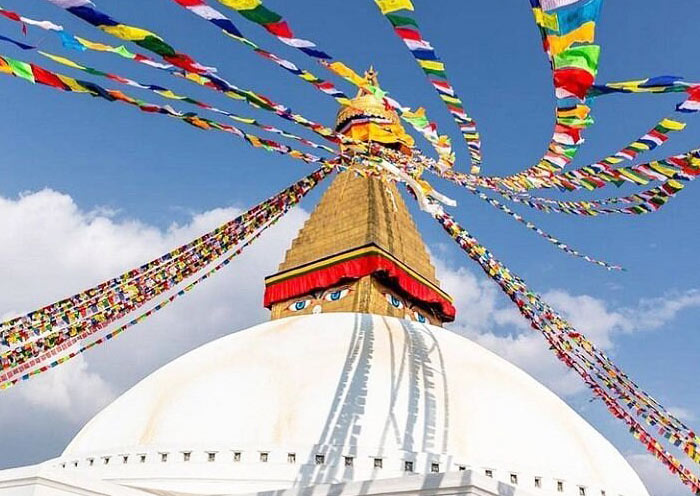


After having breakfast, it's time to leave Kathmandu and head towards Pokhara, which is about 201 kilometers away from the capital. To save time and avoid a long drive, you will take a direct flight from Kathmandu to Pokhara, which lasts for about 20-30 minutes.. (Transfer Option by Road: The drive usually takes around 5-7 hours.)
Pokhara, located in the northwest of Kathmandu, is renowned for its breathtaking natural beauty. Nestled in a picturesque valley, it offers panoramic views of the Himalayan mountain range, including the magnificent peaks of Annapurna and Dhaulagiri. Pokhara is a hub for adventure enthusiasts, providing numerous opportunities for trekking in the nearby Annapurna region. Whether you are a beginner or an experienced trekker, there are a variety of trekking routes to choose from. Additionally, Pokhara offers thrilling activities such as paragliding, zip-lining, and white-water rafting, allowing you to experience the awe-inspiring landscapes in an adventurous way.
Upon arrival in Pokhara, you will check into your hotel and take a short rest. In the afternoon, you will have the opportunity to enjoy a boating experience on Phewa Lake, which typically lasts for about 1-2 hours. Phewa Lake, the second largest lake in Nepal, is a magnificent freshwater lake surrounded by verdant hills and the awe-inspiring Annapurna mountain range. The tranquil waters of the lake beautifully reflect the majestic peaks, creating a picturesque setting that is perfect for boating. As you paddle or sail across the calm waters, you can immerse yourself in the serenity of the surroundings, providing a chance to relax, unwind, and appreciate the natural beauty that surrounds you.
While navigating the lake, keep an eye out for various colorful bird species, including kingfishers, cormorants, egrets, and herons. These beautiful creatures gracefully soar and dive around the lake, adding to the enchanting ambiance. At the center of Phewa Lake, you'll find a small island that is home to the Tal Barahi Temple, dedicated to the Hindu goddess Durga. This temple is a popular pilgrimage site, and from your boat, you can admire its pagoda-style architecture and gain a unique perspective of this religious landmark. As the sun begins to set, the atmosphere becomes even more charming, offering a beautiful and memorable moment to cherish.
Later, we will transfer you to the old part of Pokhara, where you can immerse yourself in the authentic local life of the city. Take a leisurely stroll through the bustling streets, lined with a variety of shops showcasing the rich influences of Buddhism and Hinduism. You'll also come across traditional Newari houses, adding to the cultural charm of the area. Along your walk, you'll encounter the sacred Bhimsen Temple and the revered Shree Bindhyabasini Temple, offering you a glimpse into the spiritual heritage of Pokhara.

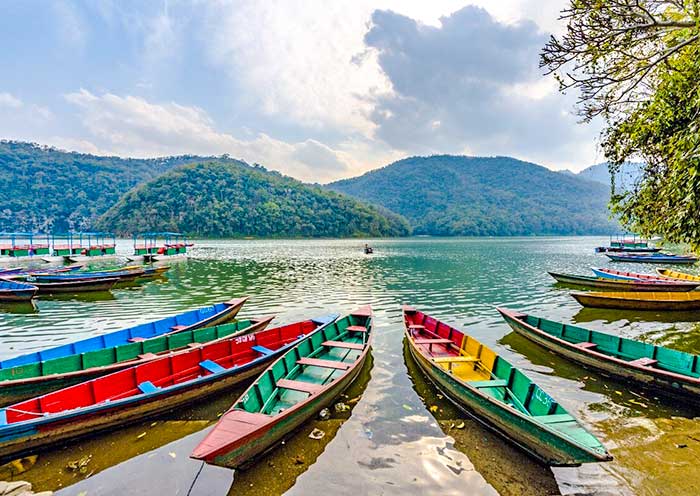

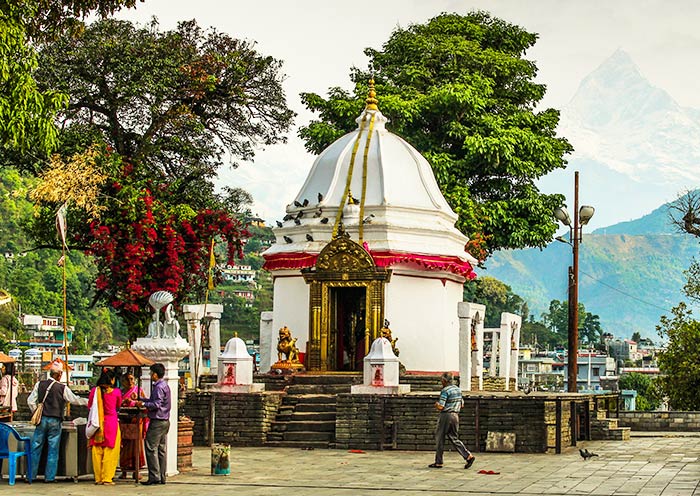
After breakfast, you will explore the International Mountain Museum. Here, you can expand your knowledge about Nepal's majestic mountain peaks and discover the tools utilized by the pioneering Himalayan mountaineers. Additionally, the museum offers engaging exhibitions and presentations that delve into the rich history, vibrant culture, geographical features, and diverse flora and fauna of the Himalayan region.
Later, you will visit Devi's Fall, also known as Patale Chhango. It's not only the cascading water that attracts visitors, but also the unique underground tunnel it carves, providing an adventurous glimpse into the "underworld." The waterfall originates from the Mardi River and plunges down a 167-foot (51-meter) cliff, creating a mesmerizing spectacle. The water continues to carve a tunnel that stretches approximately 500 feet (150 meters) in length and descends 100 feet (30 meters) underground. This offers a captivating opportunity to capture stunning photos of the waterfall, the surrounding landscape, and the vibrant flora. Next to Devi's Fall is Gupteshwor Mahadev Cave, where there is a giant stalagmite considered to be the symbol of Lord Shiva.
Next, you will enjoy a trip to the White Peace Pagoda, also known as Shanti Stupa, a magnificent Buddhist monument situated atop Ananda Hill in Pokhara, Nepal. Constructed in 1999 by Japanese monk Morioka Sonin, this pagoda stands as a symbol of global peace and unity. On the second tier of the pagoda, you will find four statues of the Buddha, graciously gifted by different countries. Each statue represents significant events in the life of the Buddha. This iconic landmark offers awe-inspiring panoramic vistas of the Annapurna mountain range, Phewa Lake, and the Pokhara Valley.
Optional experience: If you're looking for thrilling outdoor activities to try in Pokhara, we've got you covered! Feel free to share your ideas with us, and we'll be more than happy to adjust the itinerary to include your preferred activities.
- Paragliding: Soar through the skies and experience the exhilaration of paragliding over the picturesque landscapes of Pokhara. Enjoy breathtaking views of the mountains and lakes as you glide through the air.
- Zip-lining: Get your adrenaline pumping with an exciting zip-lining adventure. Fly across the stunning valleys and forests, taking in the panoramic views from high above.
- Bungee jumping: Take a leap of faith and try bungee jumping in Pokhara. Plunge from a platform into the gorge below, experiencing an adrenaline rush like no other.
- Biking: Explore the enchanting beauty of Phewa Lake and old Pokhara on a bike ride.
- Canyoning: Descend through narrow canyons and cascading waterfalls in an adrenaline-fueled canyoning adventure. Abseil down cliffs, jump into natural pools, and navigate through the stunning natural landscape.
- Kayaking: Navigate the sparkling waters of Phewa Lake or the Seti River on a kayaking adventure. Enjoy the tranquility of the surroundings as you paddle through the pristine waters.
- Stand-up paddleboarding: Try stand-up paddleboarding on the calm waters of Phewa Lake. Enjoy a unique perspective of the lake, gliding along its surface while admiring the scenic surroundings.
- White-water rafting: Experience the thrill of white-water rafting on the Seti River. Navigate through exhilarating rapids and enjoy the stunning river scenery as you paddle downstream.


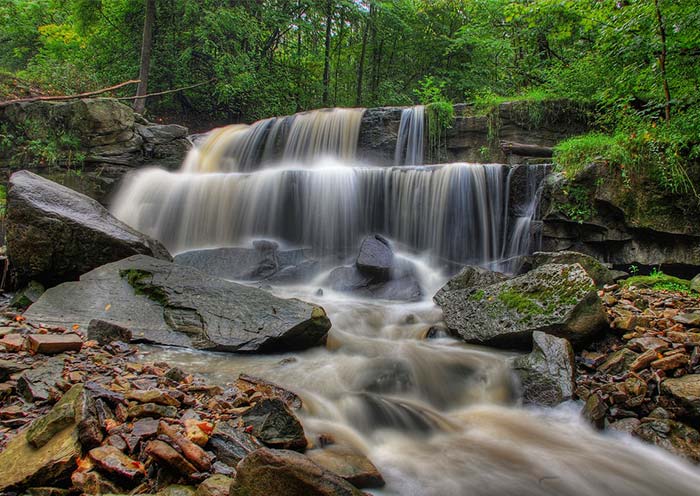

Start your day with an early morning drive to Sarangkot. After a 15-minute walk up the stairs, you will reach a fantastic viewpoint to witness the breathtaking sunrise. On clear days, you'll be able to see the awe-inspiring peaks of Dhaulagiri (8,167 meters), Machapuchhre (6,997 meters), Annapurna I (8,091 meters), Annapurna II (7,937 meters), Annapurna III (7,219 meters), and Manaslu (8,163 meters), along with a panoramic view of the Pokhara Valley. As the sun emerges from behind the mountains, the sky transforms into a mesmerizing blend of pink and orange hues, casting a golden glow upon the peaks. You'll have plenty of time to capture stunning photos and soak in the beauty of the surroundings. After the sunrise experience, drive back to your hotel, where you can enjoy a delicious breakfast.
After breakfast, take a scenic drive to Chitwan, which is about 145 kilometers away from the capital. The drive usually takes around 5 hours. (Transfer Option: To save time and avoid a long drive, you can take a direct flight from Pokhara to Chitwan, which lasts for about 30 minutes.)
Chitwan, once a royal hunting ground, was established as a national park in 1973. It is now one of the rare habitats of the Asian one-horned rhinoceros and sera last refuge for Bengal tigers. Today, the rhinoceros population has recovered to nearly 700, and Bengal tigers, crocodiles, deer, bears, leopards, as well as 525 kinds of birds, such as kingfishers, hawk, hornbill etc., thrive in Chitwan. Here, you can observe wildlife and natural surroundings, and enjoy the pleasures of outdoor activities.
In the afternoon, upon arrival in Chitwan National Park (a world heritage site), you can walk around Tharu Village to observe local tribal life and their traditional mud houses. Here, you will find an Elephant Breeding Center (optional). The purpose of this center is to protect the elephant population, and it is currently home to more than 20 elephants, including both adults and calves. Since elephants have a large appetite, the staff responsible for caring for the elephants are trained to work with adult elephants as assistants. They take the adult elephants into the jungle every day to cut grass for them. In the evening, you can enjoy the sunset by the banks of the Rapti River. You can also witness a dance performance by the Tharu ethnic group (optional). Feel free to join in the dance and immerse yourself in the warm hospitality of this exotic land.
Have a good rest at your hotel at leisure and get ready for next day’s full day jungle activities inside Chitwan National Park.


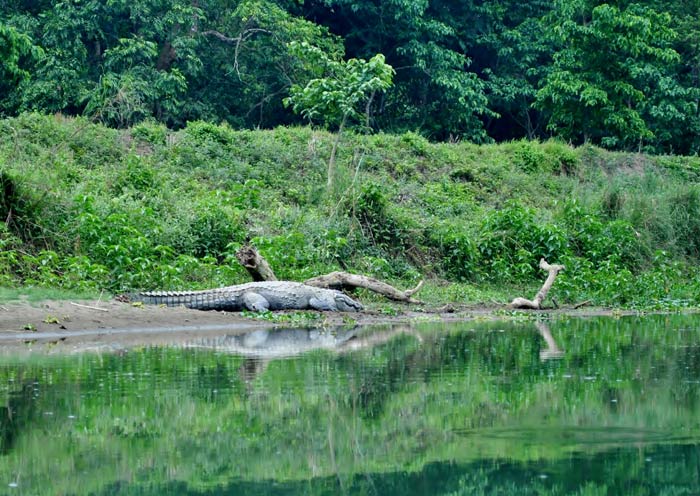

Take a full day inside Chitwan National Park, immerse yourself in nature, enjoy the jungle activities for a memorable experience. As the largest wild animal park in Nepal and one of the biggest forest parks of Asia, the Royal Chitwan National Park is the best place to enjoy bird watching, jungle walking, jeep safari, and canoeing.
During your adventure in the park, you may spot the superstar of the park - the endangered greater one-horned rhinoceros. You can explore the jungle in an open jeep (jeep safari). This is more exciting because you will have more chances to see more wild animals than riding an elephant. In Nepal's Chitwan National Park, the most commonly encountered animals are spotted deer, crocodiles, peacocks, and various bird species. The next in line are the Asian one-horned rhinoceros, turtles, and monkeys. The most elusive animals to encounter are Bengal tigers, bears, and leopards. The journey takes about 4-5 hours, and if you can, go in the morning when the animals are more active.
Canoeing (1hour; Optional) along the Rapti River is a very popular way. Sitting on the boat with local guide to watch waterfowls, crocodiles, deer and even the Gangetic dolphin, is quite relaxing and memorable. Stay overnight in Chitwan.
Jungle Activities Time Table for Reference:
1. 6:30 AM: Jeep Safari in the jungle: (Duration:4-5 Hours)
Proceed for the Jeep Safari crossing the Rapti River by Patela Boat to start with from Bhimle army check post. There are two choices of routes available, which our naturalists pick upon their experience on current sightings and animal movement.
Route 1: Bhimle post - Sukhibhar post towards Kasara (park headquarter)
Route 2: Bhimle post - Reu River- Surung Khola
Route 3: Bhimle Post - Reu River- towards Khoria Muhan Post
2. 3:00 PM: Walking Safari: (Duration:2-3 Hours)
A walk inside the National park accompanied by an experienced naturalist and nature guide to explore the wildlife, flora & fauna and birding.
(Please note that the activities will be subject to change based on the weather situation and the time.)
Warm Tips:
1.Sunset: If the weather is good, you must go to the riverside to watch the sunset! Enjoy the priceless sunset on the "East Rapti River" with the locals.
2. Dress code: Long sleeves, long pants, sneakers, and a sun hat. First, it's for sun protection, and second, to avoid scratches while trekking through the jungle. Avoid wearing bright-colored clothes to prevent disturbing the wildlife. There can be a significant temperature difference between morning and evening, so remember to stay warm and bring insect repellent.
3. Equipment: Bring a camera with a telephoto lens and binoculars (useful for capturing and observing distant animals).
4. Elephant rides: Riding an elephant can be quite bumpy, and it doesn't allow you to venture as deep into the wilderness or see as many animals as a jeep safari.
5. Jeep Safari is prohibited during monsoon season by the park authorities from Jun. -Sept. and in some season it can prolong till Oct. Although jungle exploration in Chitwan is well-established, exercise caution and be careful once you enter the forest. Avoid speaking loudly and follow the instructions of your guide to prevent any trouble.
6. Chitwan has a tropical monsoon climate, with the rainy season occurring from June to September. While you can visit during other seasons, the best time to travel is from October to March.
7. Bird watching: Nepal is home to 9% of the world's bird species, and Chitwan is one of the best birdwatching destinations in Nepal. You can allocate an additional day (at your own expense) to hire a bird watchingguide and enjoy observing and photographing birds.
8. Boat trips are also subject to water levels and local conditions on the Rapti River.

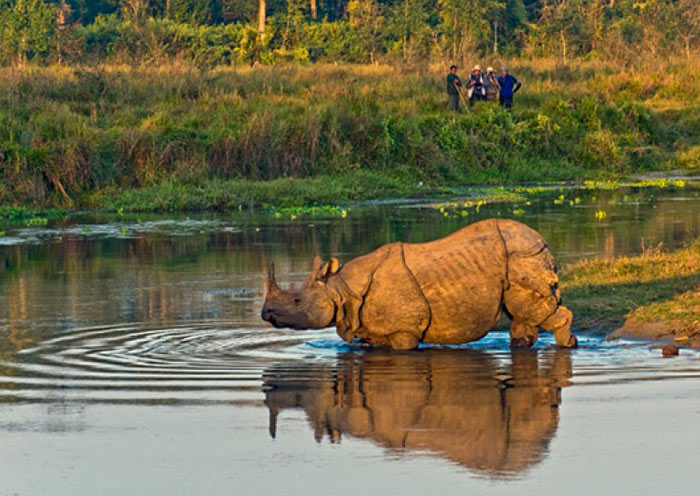

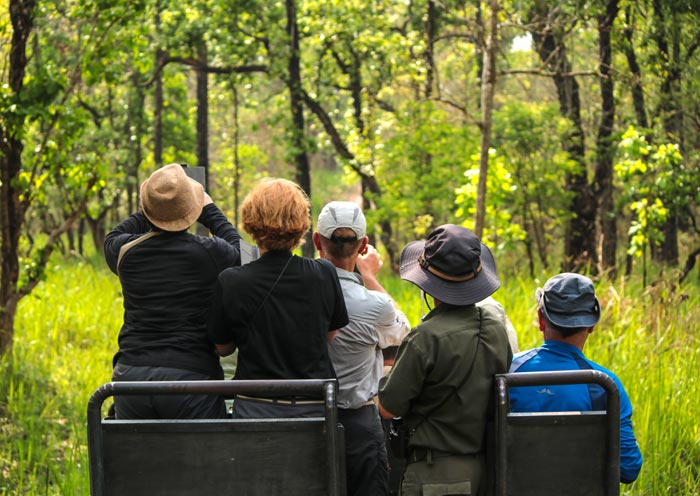
After breakfast, it's time to leave Chitwan and head back to Kathmandu, which is about 182 kilometers away. The drive usually takes around 6-7 hours.
If time and energy permit, you can make a stop at Patan Durbar Square (a World Heritage site) which is located 5km away from Kathmandu. Located in Patan (Lalitpur), this square is renowned for its ancient architectural masterpieces, including dozens of Buddhist and Hindu temples, pagodas, stone, and wood carvings. Like Kathmandu Durbar Square and Bhaktapur Durbar Square, Patan Durbar Square served as the Royal Palace of the Malla Kings before Prithivi Narayan Shah conquered the Three Malla Kingdoms of Kathmandu, Patan, and Bhaktapur in 1769 and consolidated them to found the modern state of Nepal. He also established the capital of Nepal in Kathmandu. Patan is believed to have been established around 2,300 years ago and is the oldest of the three cities that make up the Kathmandu valley. It is a dazzling display of Newari architecture such as Krishna Mandir (21 golden spires and exquisite stonework), Golden Gate (ornate golden doorway), Sundari Chowk (enchanting courtyard).
After the tour, drive to your hotel in Kathmandu.


It is time to end your 8-day Nepal tour. You will have some free time in Kathmandu and explore more on your own till your guide escorts you to the airport for your flight to your next destination
Extension Ideas: If you prefer to travel longer in Nepal, you can extend your trip to other highlighted parts of Nepal like Lumbini.
Thank you for choosing Asia Odyssey Travel (AOT) for your Nepal tour, we are always here working for you and hope to see you again for your next trip to Asia. Safe journey!
Note:
Please note that some of the sites mentioned in the itinerary may be subject to change based on factors such as the season, weather conditions, national holidays, and special events. We reserve the right to modify the itinerary to ensure an enhanced tour experience in Nepal.


Price: What’s Included & What’s Excluded
What’s Included:
What’s Excluded:
Important Travel Tips for Visiting Nepal
Before your trip, it is important to check the visa requirements for Nepal and ensure that you have all the necessary documents. The most common method of obtaining a tourist visa for Nepal is through Visa on Arrival. This means you can get your visa upon arrival at the Tribhuvan International Airport in Kathmandu or at designated land border crossings if you are entering Nepal overland.
To facilitate the visa application process, it is recommended to provide your detailed information to your travel experts before making any reservations. They can then offer you personalized suggestions and guidance regarding the visa application process. This will help ensure that you have all the necessary information and documentation to successfully apply for your Nepal visa.
Nepal's climate is diverse due to its varied topography, spanning from lowland plains to the towering Himalayas. The optimal times to visit Nepal are generally in autumn (October and November) and spring (March to May). During these seasons, the weather is mild and pleasant, making it an ideal time for outdoor activities, trekking, and mountain climbing. Additionally, important cultural festivals like Holi, Nepal Losar, Indra Jatra, and Dasain take place during these periods, adding to the vibrant atmosphere.
On the other hand, the summer season (June to September) in Nepal coincides with the monsoon season, characterized by heavy rainfall. While the monsoon brings lush greenery to the landscape, it can also lead to challenging conditions for outdoor activities.
Highways connecting major cities and towns in Nepal are generally well-maintained and in good condition. Some sections of these highways may experience occasional maintenance or repair work, which can cause temporary disruptions or delays.
If you are traveling from the Gyirong Border to Kathmandu, which is approximately 130-150 kilometers away, the journey can take around 6-7 hours by road. Similarly, if you plan to visit destinations like Pokhara, Chitwan, or Lumbini from Kathmandu, it generally takes about 5-7 hours of driving.
Alternatively, if you prefer a quicker and more convenient option, there are direct flights available from Kathmandu to Pokhara, Chitwan, and Lumbini. Considering a flight transfer can save you time and offer a more comfortable travel experience.
The official currency of Nepal is the Nepalese Rupee (NPR). It is recommended to carry a combination of cash (in small denominations) and a debit or credit card. ATMs are widely available in major cities, but may be limited in remote areas.
(1) When in Nepal, it is customary to greet others with "Namaste," a traditional greeting that involves joining your palms together in a prayer-like gesture and saying "Namaste" while slightly bowing. This gesture shows respect and is widely appreciated.
(2) Nepal is home to a significant population practicing Hinduism and Buddhism. It is important to demonstrate respect when visiting religious sites. Remember to dress modestly, remove your shoes, and adhere to any specific rules or rituals observed at each location, such as covering your shoulders or refraining from certain actions.
(3) If you wish to take photographs of religious ceremonies or individuals, it is polite to seek permission first. Some religious sites may have restrictions on photography, and it's important to respect the privacy and sacredness of the moment.
(4) Nepal celebrates numerous festivals throughout the year, providing a fantastic opportunity to immerse yourself in the vibrant culture and traditions. During these festive occasions such as Dashain, Tihar, Holi, and Buddha Jayanti, it is customary to exchange greetings, offer and receive blessings, and participate in religious rituals. Embrace the festive spirit and engage respectfully in the celebrations.
(5) By being mindful of these customs and traditions, you can show your appreciation for the Nepalese culture and ensure a more enjoyable and respectful experience during your visit.
Hotel Conditions for Your Nepal Tour




In Nepal, most travelers typically allocate 3-4 nights in Kathmandu, 2 nights in Pokhara, 2 nights in Chitwan, 1 night in Nagarkot, or 2 nights in Lumbini. To cater to various travelers' preferences and budgets, we offer a range of carefully chosen accommodations, including luxurious 5-star hotels, comfortable 4-star options, and economical 3-star establishments.
Find your perfect hotel for a great experience: We offer a diverse selection of hotels in Nepal, catering to all types of travelers. Our knowledgeable travel experts can provide you with various pricing options based on different hotels. Whether you seek a luxurious stay or have specific preferences, our experts will assist you in choosing the best option that suits your needs.
Photo Gallery for This Itinerary
Latest Nepal Tours Reviews from Our Customers

Clive
Britain
Destination(s): Tibet
Date of Experience: Oct 21, 2024
Tour Customized by: Alina
You May be Interested in This Tour: Customized Tour

Jim
Australia
What a wonderful experience we had, with fabulous support from Alina at Asia Odyssey and from our great driver Vipin and our guides (Prerak in Delhi, Sanjay in Agra and Suresh in Jaipur). The guides were knowledgeable, communicative and friendly, and all had a good appreciation as well of food, which meant their restaurant suggestions were excellent. Vipin accompanied us throughout our trip and shared many things with us, beyond being a driver, including taking us to the Galvani Hindu temple in Jaipur.
What an amazing trip. We did the Golden Triangle, which has a particular focus on the architecture and history of the Mughul empire, especially Shah Jahan, who built the Taj Mahal. And the buildings are spectacular! The Taj is most known, and I found the inlay work (precious stones inlaid in the white marble) to be the highlight. We bought a marble elephant done in the same way as a reminder of the walls of the Taj - seeing the actual artisans doing this inlay work in with traditional tools added to our experience and we were delighted to buy some of their special work.
Having said that, my personal preference was for the red sandstone buildings rather than the white marble. The detailed work of carving the sandstone is for me as beautiful as the similar work on the marble, and the colours are nicer, softer.
Similarly, the timber constructions in Nepal were unbelievable - as detailed as the work we saw in India, and wonderfully maintained, even if it has experienced significant impacts from earthquakes.
The photos below highlight our experiences - the captions provide the rest of the detail.
Date of Experience: Sep 19, 2024
Tour Customized by: Alina
You May be Interested in This Tour: Customized Tour

Molly Durnas
US
I just graduated college and was planning on solo traveling Asia for 3 months. In the beginning of May, my mother very last minute decided that she would join me for a few weeks starting in the beginning of June. We both were very busy and had to quickly come up with a plan, which is when we found Asia Odyssey. Alina was super prompt in her response and quickly made us an itinerary for Nepal and Bhutan that fit exactly to our needs. After seeing how expertly Alina was able to create this itinerary, we also requested she make us an itinerary for India’s Golden Triangle including Delhi, Agra, and Rajasthan that we would embark on before Nepal/Bhutan.
Altogether we were under the care of Asia Odyssey for about a month, and simply could not have had a better experience. Alina was constantly in contact with us to make sure that everything was going smoothly and that we were having a wonderful time. In Nepal, we very last minute changed our plan to fly instead of drive for two of our locations and Alina was so understanding and helpful in allowing us to change our plans. Alina truly took wonderful care of us from start to finish and she is such a gem. Thank you so much for everything Alina!
Our trip to India felt right out of a magazine. Our driver Satish in India was with us over a week and is one of the kindest, most genuine people I have ever met in my entire life. I’ve been wanting to go to India with my mother for years and the trip was absolutely perfect - every hotel, every restaurant, every sight was absolutely wonderful. I was blown away with the country and the culture, and Asia Odyssey allowed us to experience it in the most comfortable and seamless way.
Our adventures in Nepal and Bhutan were some of the best of my life! The mountains and culture were unlike anything I’d experienced before, and I truly felt that I was able to get a genuine feel for the countries. The mountains and all of the buddhist monasteries and temples were some of the most beautiful things I’ve seen in my life. I absolutely cannot wait to come back - and when I do it will definitely be with Asia Odyssey.
Our guides Prarek, Ganesh, Narendra, Amit, Ghana, and Jigme throughout India, Nepal and Bhutan were all absolutely amazing, as were our drivers Satish, Keshav, and Momlal. Every single person we met was so incredible and made us feel so welcomed.
I cannot speak highly enough of Asia Odyssey and the hospitality shown by all involved in our trip. Thank you so much for the trip of a lifetime, and we hope to return very soon!
Date of Experience: Jun 01, 2024
Tour Customized by: Alina
You May be Interested in This Tour: Customized Tour
Price: Request
(Based on a private tour for two people. Price varies depending on program, travel date, number of people.)
Free Enquiry! You don’t need to pay for the reservation.
- United States (+1)
- Australia (+61)
- Singapore (+65)
- Malaysia (+60)
- Philippines (+63)
- Canada (+1)
- Italy (+39)
- Indonesia (+62)
- United Kingdom (+44)
- Spain (+34)
- Mexico (+52)
- Hong Kong (+852)
- Thailand (+66)
- United Arab Emirates (+971)
- New Zealand (+64)
- South Africa (+27)
- Germany (+49)
- Brazil (+55)
- India (+91)
- France (+33)
- Vietnam (+84)
- The Netherlands (+31)
- Saudi Arabia (+966)
- Ireland (+353)
- Argentina (+54)
- Switzerland (+41)
- Romania (+40)
- Pakistan (+92)
- Japan (+81)
- Portugal (+351)
- Bangladesh (+880)
- South Korea (+82)
- Puerto Rico (+1)
- Türkiye (+90)
- China (+86)
- Belgium (+32)
- Qatar (+974)
- Greece (+30)
- Taiwan (+886)
- Austria (+43)
- Poland (+48)
- Israel (+972)
- Chile (+56)
- Sri Lanka (+94)
- Nigeria (+234)
- Peru (+51)
- Colombia (+57)
- Hungary (+36)
- Nepal (+977)
- Denmark (+45)
- Bulgaria (+359)
- Norway (+47)
- Slovenia (+383)
- Sweden (+46)
- Kuwait (+965)
- Costa Rica (+506)
- Ecuador (+593)
- Venezuela (+58)
- Malta (+356)
- Croatia (+385)
- Tunisia (+216)
- Czechia (+420)
- Mongolia (+976)
- Bahrain (+973)
- Mauritius (+230)
- Papua New Guinea (+675)
- Cambodia (+855)
- Dominican Republic (+1)
- Luxembourg (+352)
- Finland (+358)
- Guatemala (+502)
- Myanmar (+95)
- Maldives (+960)
- Slovakia (+421)
- Laos (+856)
- Serbia (+381)
- Brunei (+673)
- Oman (+968)
- Macao (+853)
- Panama (+507)
- Morocco (+212)
- Jordan (+962)
- Georgia (+995)
- Fiji (+679)
- Bolivia (+591)
- Lithuania (+370)
- Bahamas (+1)
- Cyprus (+357)
- Latvia (+371)
- Bhutan (+975)
- Iraq (+964)
- Iran (+98)
- Kenya (+254)
- Jamaica (+1)
- Zimbabwe (+263)
- Azerbaijan (+994)
- Uruguay (+598)
- Estonia (+372)
- Andorra (+376)
- Cameroon (+237)
- Ghana (+233)
- Kazakhstan (+7)
- Nicaragua (+505)
- Egypt (+20)
- Russia (+7)
- Albania (+355)
- Réunion (+262)
- Montenegro (+382)
- Algeria (+213)
- Afghanistan (+93)
- Martinique (+596)
- Uganda (+256)
- Honduras (+504)
- North Macedonia (+389)
- Trinidad and Tobago (+1)
- Suriname (+597)
- Antigua and Barbuda (+1)
- Zambia (+260)
- Ukraine (+380)
- Armenia (+374)
- Barbados (+1)
- Belarus (+375)
- Palestine (+970)
- Lesotho (+266)
- Moldova (+373)
- Ethiopia (+251)
- French Polynesia (+689)
- Gambia (+220)
- Guam (+1)
- Gibraltar (+350)
- Isle of Man (+44)
- New Caledonia (+687)
- El Salvador (+503)
- Comoros (+269)
- Seychelles (+248)
- Chad (+235)
- Samoa (+685)
- Cook Islands (+682)
- Palau (+680)
- Paraguay (+595)
- DR Congo (+243)
- Solomon Islands (+677)

